2012 TOYOTA VERSO tire type
[x] Cancel search: tire typePage 280 of 588

280 2-5. Driving information
VERSO_WE_OM64524E
Selecting tire chains
Use the correct tire chain size when mounting the tire chains.
Chain size is regulated for each tire size.
Side chain
3 mm (0.12 in.) in diameter
10 mm (0.39 in.) in width
30 mm (1.18 in.) in length
Cross chain
4 mm (0.16 in.) in diameter
14 mm (0.55 in.) in width
25 mm (0.98 in.) in length
Regulations on the use of tire chains
Regulations regarding the use of tire chains vary according to loca-
tion and type of road. Always check local regulations before install-
ing chains.
Install the chains on the front tires.
Retighten the chains after driving 0.5 - 1.0 km (1/4 - 1/2 mile).
Tire chains
Observe the following precautions when installing and removing chains:
Install and remove tire chains in a safe location.
Install tire chains on the front tires only. Do not install the chains on the
rear tires.
Install tire chains following the instructions provided in the accompanying
manual.
Page 421 of 588
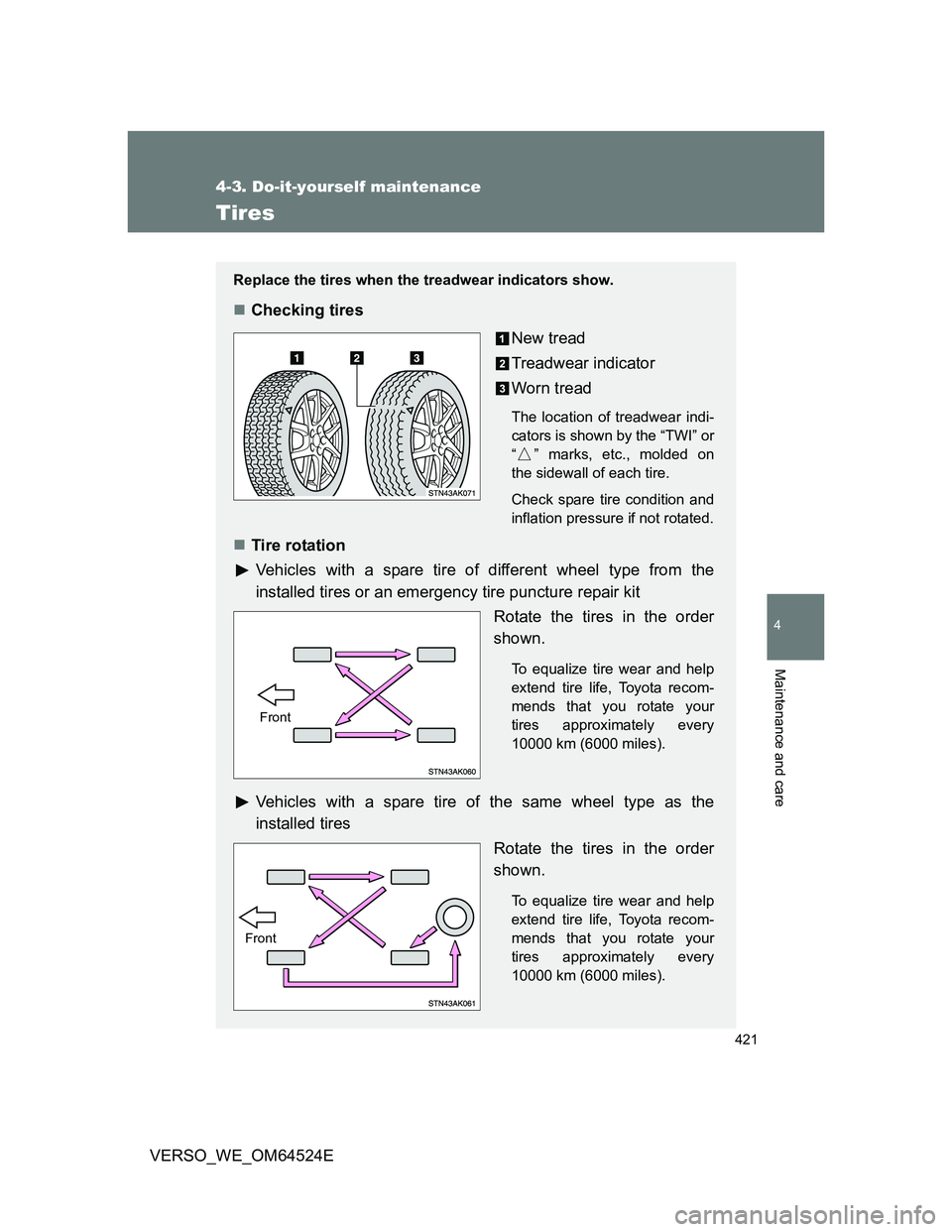
421
4-3. Do-it-yourself maintenance
4
Maintenance and care
VERSO_WE_OM64524E
Tires
Replace the tires when the treadwear indicators show.
Checking tires
New tread
Treadwear indicator
Worn tread
The location of treadwear indi-
cators is shown by the “TWI” or
“ ” marks, etc., molded on
the sidewall of each tire.
Check spare tire condition and
inflation pressure if not rotated.
Tire rotation
Vehicles with a spare tire of different wheel type from the
installed tires or an emergency tire puncture repair kit
Rotate the tires in the order
shown.
To equalize tire wear and help
extend tire life, Toyota recom-
mends that you rotate your
tires approximately every
10000 km (6000 miles).
Vehicles with a spare tire of the same wheel type as the
installed tires
Rotate the tires in the order
shown.
To equalize tire wear and help
extend tire life, Toyota recom-
mends that you rotate your
tires approximately every
10000 km (6000 miles).
Front
Front
Page 426 of 588

426
4-3. Do-it-yourself maintenance
VERSO_WE_OM64524E
Wheels
If a wheel is bent, cracked or heavily corroded, it should be replaced.
Otherwise, the tire may separate from the wheel or cause loss of
handling control.
Wheel selection
When replacing wheels, care should be taken to ensure that
they are equivalent to those removed in load capacity, diameter,
rim width, and inset
*.
Replacement wheels are available at any authorized Toyota
dealer or repairer, or another duly qualified and equipped profes-
sional.
*: Conventionally referred to as “offset”.
Toyota does not recommend using:
Wheels of different sizes or types
Used wheels
Bent wheels that have been straightened
Aluminum wheel precautions (if equipped)
Use only Toyota wheel nuts and wrenches designed for use
with your aluminum wheels.
When rotating, repairing or changing your tires, check that the
wheel nuts are still tight after driving 1600 km (1000 miles).
Be careful not to damage the aluminum wheels when using
tire chains.
Use only Toyota genuine balance weights or equivalent and a
plastic or rubber hammer when balancing your wheels.
Page 504 of 588
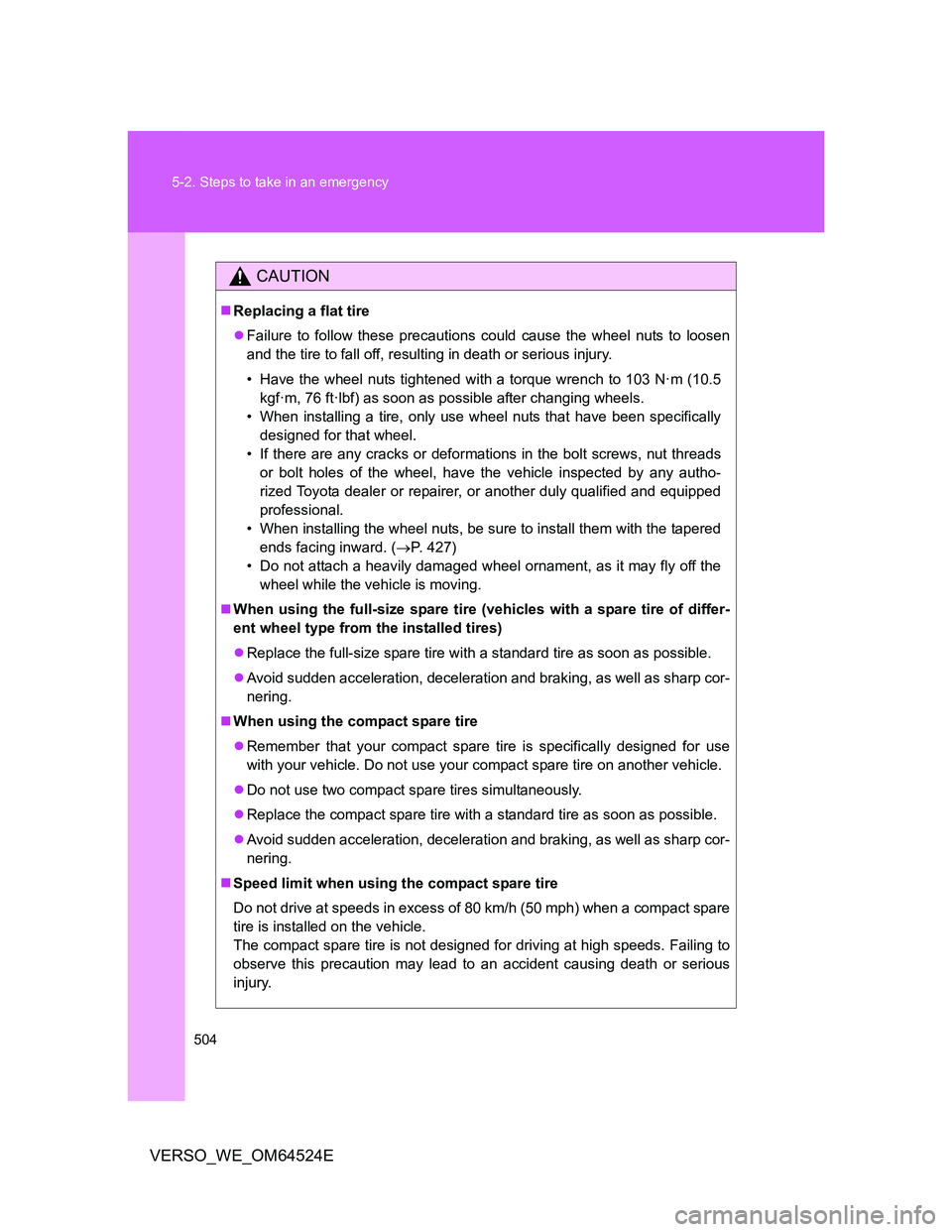
504 5-2. Steps to take in an emergency
VERSO_WE_OM64524E
CAUTION
Replacing a flat tire
Failure to follow these precautions could cause the wheel nuts to loosen
and the tire to fall off, resulting in death or serious injury.
• Have the wheel nuts tightened with a torque wrench to 103 N·m (10.5
kgf·m, 76 ft·lbf) as soon as possible after changing wheels.
• When installing a tire, only use wheel nuts that have been specifically
designed for that wheel.
• If there are any cracks or deformations in the bolt screws, nut threads
or bolt holes of the wheel, have the vehicle inspected by any autho-
rized Toyota dealer or repairer, or another duly qualified and equipped
professional.
• When installing the wheel nuts, be sure to install them with the tapered
ends facing inward. (P. 427)
• Do not attach a heavily damaged wheel ornament, as it may fly off the
wheel while the vehicle is moving.
When using the full-size spare tire (vehicles with a spare tire of differ-
ent wheel type from the installed tires)
Replace the full-size spare tire with a standard tire as soon as possible.
Avoid sudden acceleration, deceleration and braking, as well as sharp cor-
nering.
When using the compact spare tire
Remember that your compact spare tire is specifically designed for use
with your vehicle. Do not use your compact spare tire on another vehicle.
Do not use two compact spare tires simultaneously.
Replace the compact spare tire with a standard tire as soon as possible.
Avoid sudden acceleration, deceleration and braking, as well as sharp cor-
nering.
Speed limit when using the compact spare tire
Do not drive at speeds in excess of 80 km/h (50 mph) when a compact spare
tire is installed on the vehicle.
The compact spare tire is not designed for driving at high speeds. Failing to
observe this precaution may lead to an accident causing death or serious
injury.
Page 516 of 588
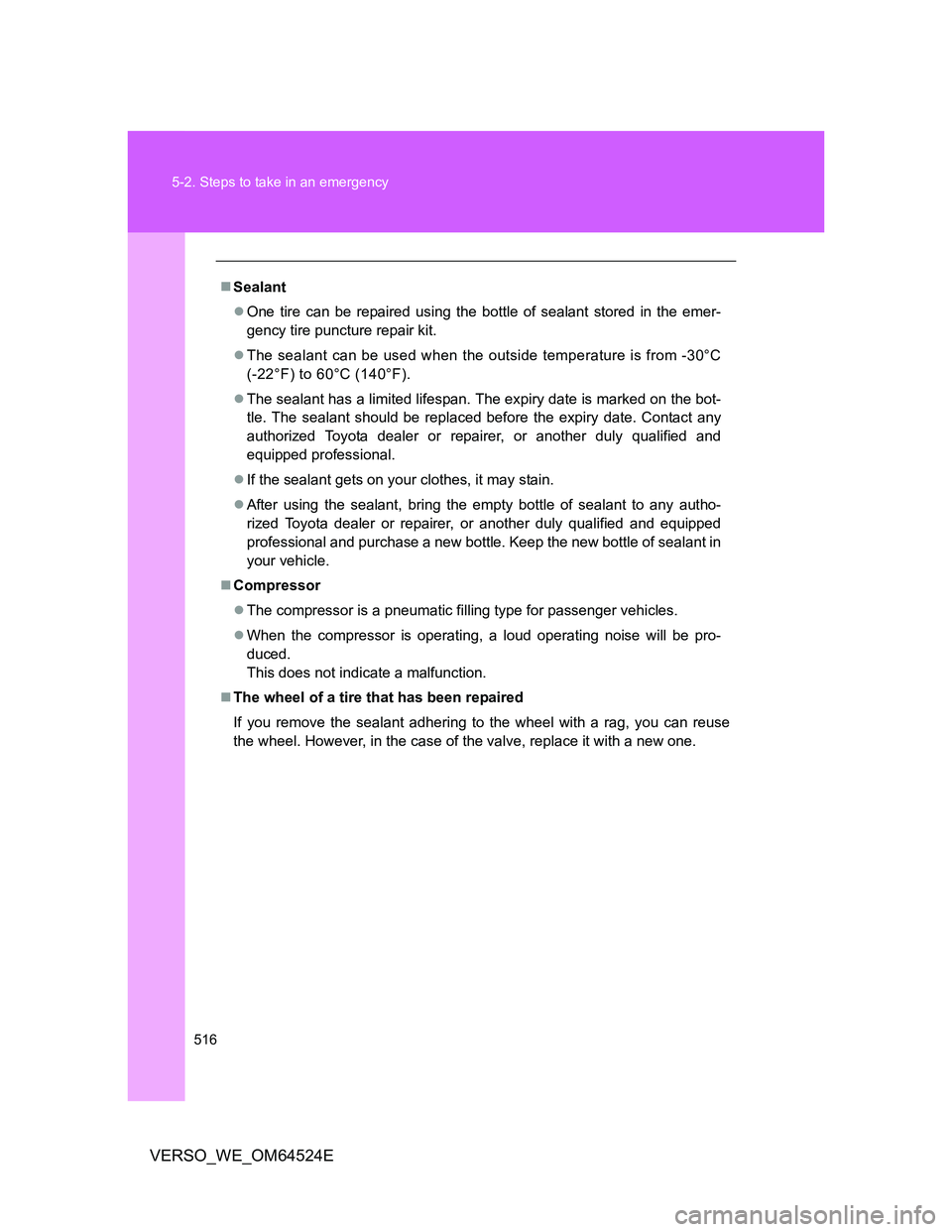
516 5-2. Steps to take in an emergency
VERSO_WE_OM64524E
Sealant
One tire can be repaired using the bottle of sealant stored in the emer-
gency tire puncture repair kit.
The sealant can be used when the outside temperature is from -30°C
(-22°F) to 60°C (140°F).
The sealant has a limited lifespan. The expiry date is marked on the bot-
tle. The sealant should be replaced before the expiry date. Contact any
authorized Toyota dealer or repairer, or another duly qualified and
equipped professional.
If the sealant gets on your clothes, it may stain.
After using the sealant, bring the empty bottle of sealant to any autho-
rized Toyota dealer or repairer, or another duly qualified and equipped
professional and purchase a new bottle. Keep the new bottle of sealant in
your vehicle.
Compressor
The compressor is a pneumatic filling type for passenger vehicles.
When the compressor is operating, a loud operating noise will be pro-
duced.
This does not indicate a malfunction.
The wheel of a tire that has been repaired
If you remove the sealant adhering to the wheel with a rag, you can reuse
the wheel. However, in the case of the valve, replace it with a new one.
Page 518 of 588
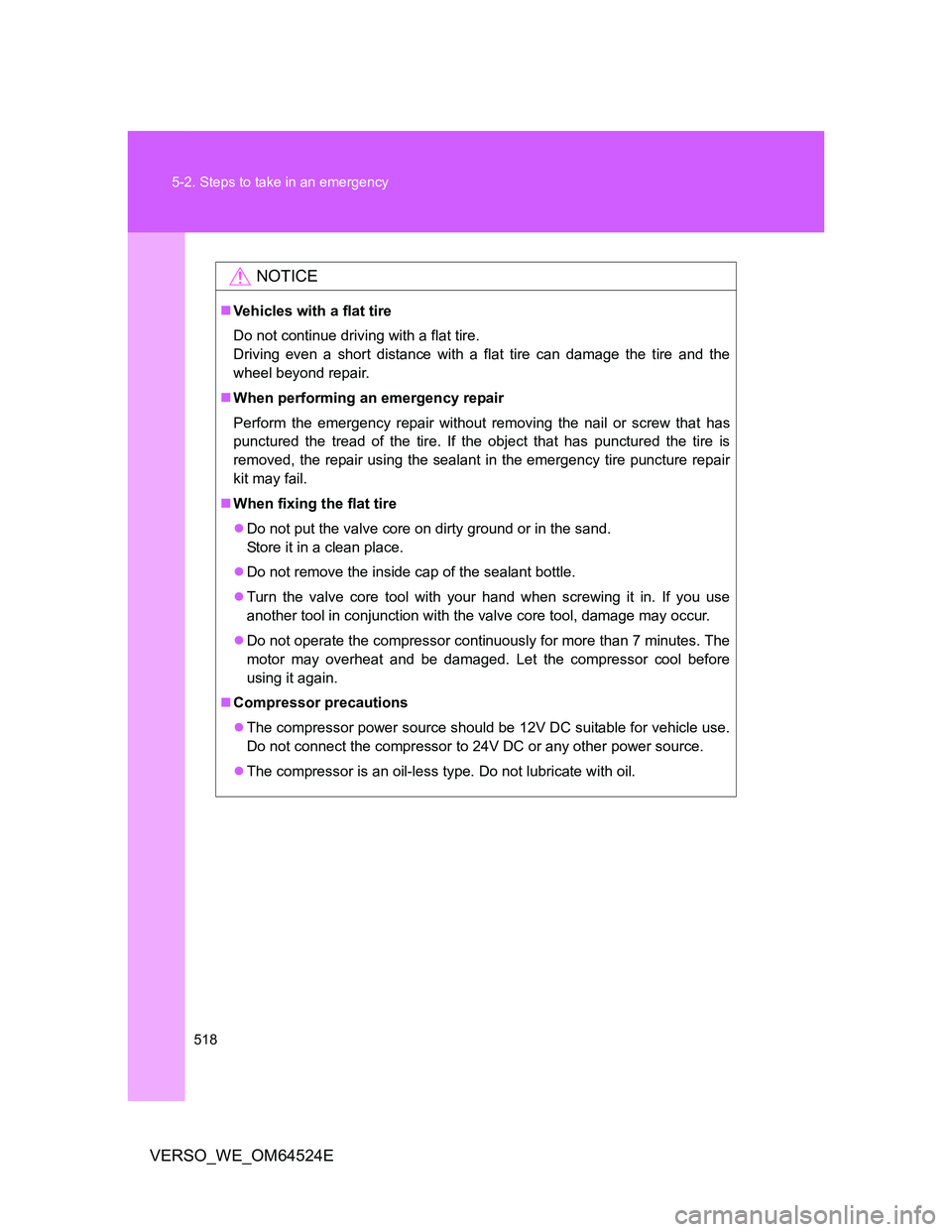
518 5-2. Steps to take in an emergency
VERSO_WE_OM64524E
NOTICE
Vehicles with a flat tire
Do not continue driving with a flat tire.
Driving even a short distance with a flat tire can damage the tire and the
wheel beyond repair.
When performing an emergency repair
Perform the emergency repair without removing the nail or screw that has
punctured the tread of the tire. If the object that has punctured the tire is
removed, the repair using the sealant in the emergency tire puncture repair
kit may fail.
When fixing the flat tire
Do not put the valve core on dirty ground or in the sand.
Store it in a clean place.
Do not remove the inside cap of the sealant bottle.
Turn the valve core tool with your hand when screwing it in. If you use
another tool in conjunction with the valve core tool, damage may occur.
Do not operate the compressor continuously for more than 7 minutes. The
motor may overheat and be damaged. Let the compressor cool before
using it again.
Compressor precautions
The compressor power source should be 12V DC suitable for vehicle use.
Do not connect the compressor to 24V DC or any other power source.
The compressor is an oil-less type. Do not lubricate with oil.
Page 588 of 588
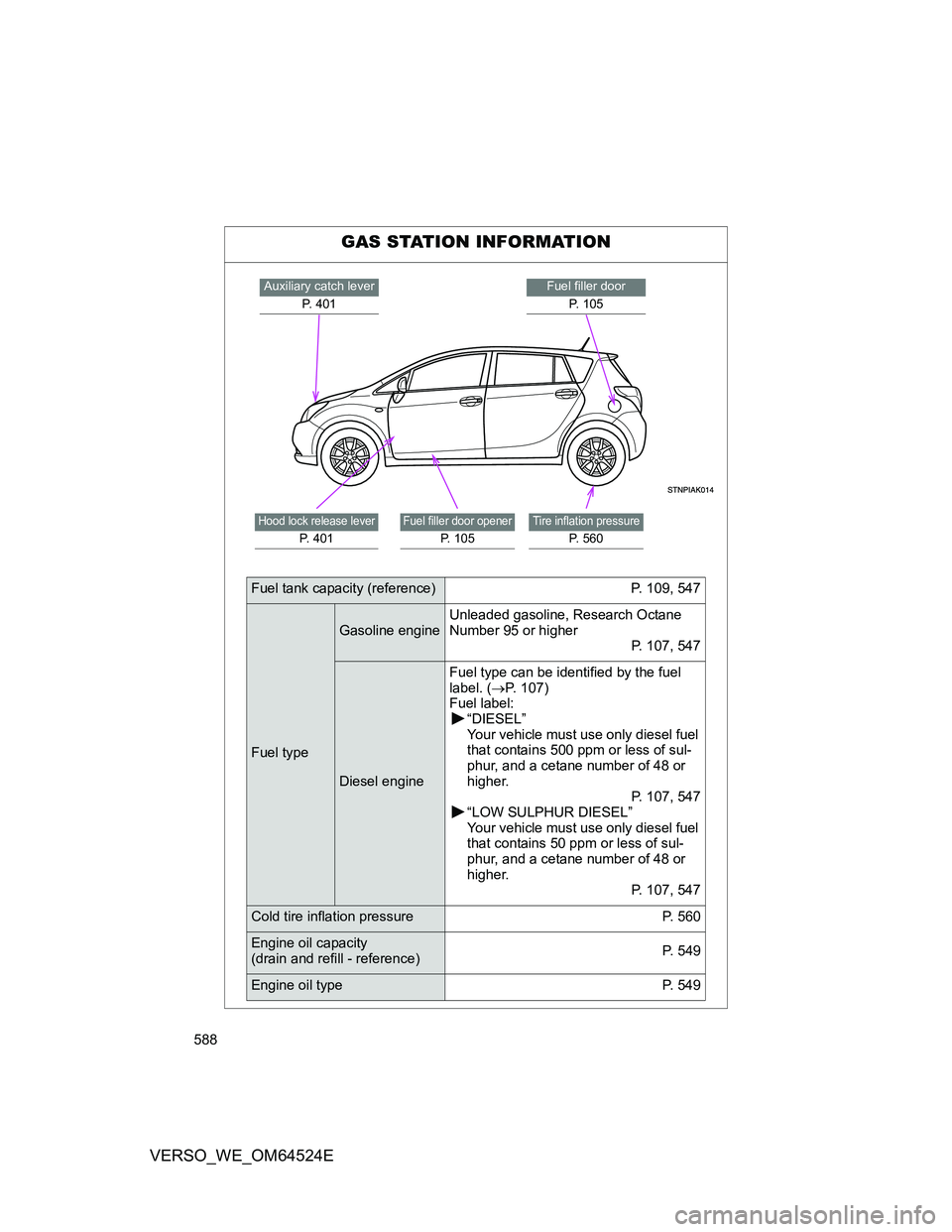
588
VERSO_WE_OM64524E
GAS STATION INFORMATION
Fuel filler door
P. 105Auxiliary catch lever
P. 401
Tire inflation pressure
P. 560
Fuel filler door opener
P. 105
Hood lock release lever
P. 401
Fuel tank capacity (reference) P. 109, 547
Fuel type
Gasoline engineUnleaded gasoline, Research Octane
Number 95 or higher
P. 107, 547
Diesel engineFuel type can be identified by the fuel
label. (P. 107)
Fuel label:
“DIESEL”
Your vehicle must use only diesel fuel
that contains 500 ppm or less of sul-
phur, and a cetane number of 48 or
higher.
P. 107, 547
“LOW SULPHUR DIESEL”
Your vehicle must use only diesel fuel
that contains 50 ppm or less of sul-
phur, and a cetane number of 48 or
higher.
P. 107, 547
Cold tire inflation pressure P. 560
Engine oil capacity
(drain and refill - reference)P. 549
Engine oil type P. 549